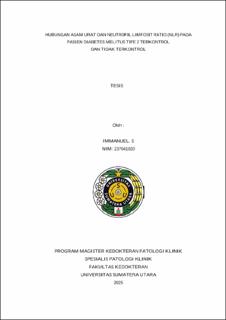Hubungan Asam Urat dan Neutrofil Limfosit Ratio (Nlr) pada Pasien Diabetes Melitus Tipe 2 Terkontrol dan Tidak Terkontrol
Corelation Between Uric Acid and Neutrophil Lymphocyte Ratio (Nlr) in Controlled and Uncontrolled Type 2 Diabetes Mellitus

Date
2025Author
Situmorang, Immanuel
Advisor(s)
Siregar, Jelita
Syafril, Santi
Metadata
Show full item recordAbstract
Background:Type 2 diabetes mellitus (DM) is a metabolic disease characterised by chronic hyperglycaemia resulting from defects in insulin secretion, insulin action or both and is often associated with various metabolic complications and inflammatory conditions. Uric acid and Neutrophil Lymphocyte Ratio (NLR) have been reported to act as biomarkers of inflammation and oxidative stress that are increased in the condition. This study aims to determine the relationship between uric acid levels and NLR in controlled and uncontrolled type 2 DM patients.
Subject and Method: The research design used was analytical observational with a cross-sectional approach. The sample consisted of 112 subjects who were divided into two groups, namely controlled (HbA1c < 7%) and uncontrolled (HbA1c ≥ 7%) type 2 DM patients and obtained controlled (n=56) and uncontrolled (n=56) DM groups. Data collection was conducted at RSUP H. Adam Malik Medan through laboratory examination of whole blood, uric acid, and HbA1c. Statistical analysis used Pearson or Spearman correlation test to see the relationship between variables. A p value of less than 0.05 is applied to each statistical test as significant
Results: Based on data analysis of 112 study subjects, there were significant differences in several demographic characteristics such as age, weight, BMI, gender, and occupation. In uncontrolled Type 2 Diabetes Mellitus, most of the study subjects were man (60,7%), age 56,72 ± 11,27 y.o and BMI 21,72. In Controlled type 2 Diabetes Mellitus, most of the study subjects were woman (58,9%), age 52,95 ± 11,60 y.o and BMI 32,24 kg/m². Uric acid and HbA1c levels showed highly significant differences between the two groups, with higher levels in the uncontrolled DM group (uric acid 8,23 ±1,15 mg/dL, HbA1C 8,25%). Positive correlations were found between uric acid and NLR (Controlled Type 2 Diabetes Mellitus: p 0,010, r 0,696, Uncontrolled Type 2 Diabetes Mellitus: p 0,024, r 0,468) , Uric acid and HbA1c (Controlled Type 2 Diabetes Mellitus p 0,012, r 0,427, Uncontrolled Type 2 Diabetes Mellitus p 0,011, r 0,474) in both groups, although the strength of the correlations varied. In addition, a strong positive association was also seen between HbA1c and NLR in both the controlled (p 0,029, r 0,586) and uncontrolled (p 0,031, r 0,585) type 2 DM groups.
Conclusion: There is a correlation between uric acid and Neutrophil Lymphocyte Ratio, uric acid and HbA1C, HbA1C and Neutrophil Lymphocyte Ratio in controlled and uncontrolled Type 2 Diabetes Mellitus
